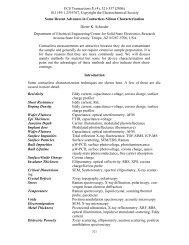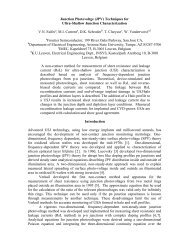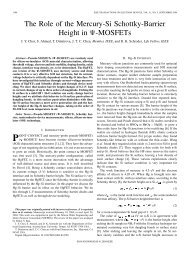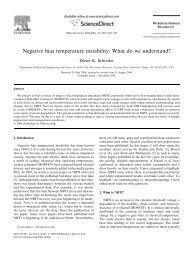Surface voltage and surface photovoltage - Dieter Schroder ...
Surface voltage and surface photovoltage - Dieter Schroder ...
Surface voltage and surface photovoltage - Dieter Schroder ...
You also want an ePaper? Increase the reach of your titles
YUMPU automatically turns print PDFs into web optimized ePapers that Google loves.
<strong>Surface</strong> <strong>voltage</strong> <strong>and</strong> <strong>surface</strong> photo<strong>voltage</strong><br />
Probe<br />
φ s<br />
V s<br />
-<br />
V P<br />
p-type<br />
V P<br />
+<br />
+<br />
+<br />
Q Q S<br />
-<br />
-<br />
p-type<br />
t air<br />
E vac /q<br />
V,<br />
φ<br />
W M<br />
W S<br />
φ s<br />
E c /q<br />
φ = 0<br />
E v /q<br />
x<br />
φ F<br />
V P<br />
φ s<br />
= V s<br />
(a)<br />
(b)<br />
Figure 3. Cross section <strong>and</strong> b<strong>and</strong> diagram of a metal–air–semiconductor system with zero work function difference: (a) no <strong>surface</strong> charge,<br />
(b) with <strong>surface</strong> charge.<br />
V ox<br />
Q 1<br />
V G φ s<br />
V G<br />
+<br />
+ +<br />
+<br />
+<br />
ρ ox<br />
p-type<br />
0 x 1 t ox x<br />
(a)<br />
(b)<br />
Figure 4. (a) MOS capacitor cross section showing a charge sheet Q 1 at x = x 1 <strong>and</strong> uniform charge ρ ox throughout the oxide; (b) the<br />
corresponding b<strong>and</strong> diagram showing oxide <strong>and</strong> <strong>surface</strong> potentials.<br />
Let us now extend this example to a Kelvin probe held<br />
above a semiconductor covered with an insulator <strong>and</strong> a probe–<br />
semiconductor work function difference W MS leading to the<br />
negative probe potential V P = W MS in figure 5(a). Next<br />
consider oxide charge density ρ ox (C cm −3 ) <strong>and</strong> <strong>surface</strong> charge<br />
density Q (C cm −2 )asinfigure 5(b). These charges induce<br />
charge density qN A W in the semiconductor (indicated by the<br />
negative charges) <strong>and</strong> qn on the probe (indicated by the solid<br />
circles, representing electrons). The probe <strong>voltage</strong>, calculated<br />
with the same approach as used for MOS capacitors, is<br />
V P = V FB + V air + V ox + φ. (7)<br />
The flatb<strong>and</strong> <strong>voltage</strong> in this case is<br />
V FB = W MS − t air<br />
t equ<br />
Q<br />
C equ<br />
− 1<br />
C equ<br />
∫ tequ<br />
t air<br />
x<br />
t equ<br />
ρ ox dx (8)<br />
where C equ is the equivalent capacitance <strong>and</strong> t equ the equivalent<br />
thickness given by<br />
C equ =<br />
C airC ox<br />
C air + C ox<br />
= ε 0<br />
t equ<br />
t equ = t air + t ox /K ox . (9)<br />
Equations (7)–(9) show the probe <strong>voltage</strong> to be due to W MS ,<br />
Q <strong>and</strong> ρ ox . A single measurement is unable to distinguish<br />
between these three parameters.<br />
Next we will consider the effect of light on the sample. For<br />
simplicity, we will use the bare sample in figure 6. Figure 6(a)<br />
shows the b<strong>and</strong> diagram with <strong>surface</strong> charge density Q in<br />
the dark <strong>and</strong> in figure 6(b) the sample is strongly illuminated<br />
driving the semiconductor to the flatb<strong>and</strong> condition <strong>and</strong> the<br />
probe potential approaches zero. Hence by measuring the<br />
<strong>surface</strong> <strong>voltage</strong> without <strong>and</strong> with light, we obtain the <strong>surface</strong><br />
potential <strong>and</strong> hence the charge density from equation (4). To<br />
underst<strong>and</strong> how this comes about, we must look at the flatb<strong>and</strong><br />
condition in more detail.<br />
The semiconductor charge density Q S for a p-type<br />
semiconductor in depletion or inversion is<br />
Q S =− √ 2kT K s ε 0 n i F(U S ,K) (10)<br />
where F is the normalized <strong>surface</strong> electric field, defined as [26]<br />
F(U S ,K)= [K(e −US + U S − 1) + K −1 (e US − U S − 1)<br />
+K(e US +e −US − 2)] 1/2 . (11)<br />
In this expression K = p 0 /n i (p 0 is the majority carrier<br />
density <strong>and</strong> n i the intrinsic carrier density), U s = qφ s /kT<br />
is the normalized <strong>surface</strong> potential, φ s the <strong>surface</strong> potential<br />
<strong>and</strong> the normalized excess carrier density ( = p/p 0 ,<br />
where p = n is the excess carrier density). In the<br />
absence of excess carriers, i.e., in equilibrium, the last term<br />
in equation (11) vanishes.<br />
F is plotted versus φ s in figure 7 as a function of the<br />
normalized excess carrier density, produced by illuminating<br />
the device. The electric field is related to the charge density<br />
through equation (10). Constant charge implies constant<br />
R19








